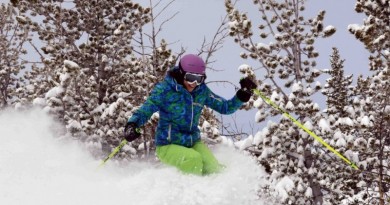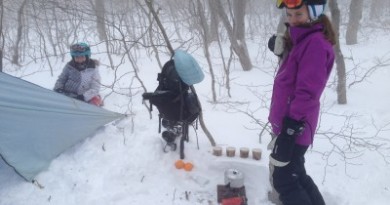Looking Uphill? Know Before You Go
Although hiking and skinning are becoming more popular, it is still important to know the resort policies before you start.
For the tough, skiing means more than Vermont’s resorts and Nordic centers, it also means getting into the backcountry. The thrill of undiscovered snow draws many looking to make tracks where the snow is deep and the crowds are nonexistent. In recent months, a committed group of backcountry skiers and riders called the Vermont Backcountry Alliance (VTBC) are working on conserving popular areas, educating users and working with communities to develop strategies to preserve and manage backcountry skiing terrain.
Meanwhile in central Vermont, The Rochester Area Sport Trails Alliance (RASTA), a group of mountain bikers and backcountry-oriented skiers, has been named an official test chapter of the Catamount Trail Association and is working with property owners and the USDA Forest Service to develop more multiple use trails.
This October, RASTA members, working under the supervision of a forester, developed a 1,000 vertical foot glade down the side of Skidoo Mountain, one of a series of peaks in the newly created Braintree Mountain Forest, a 1,500-acre wilderness donated by the local landowner. The group plans to develop a total of three gladed zones over five years in the forest that will be open to public use.
This winter, the USDA Forest Service considers a proposal to develop four backcountry skiing glades totaling approximately 210 acres on land in the Green Mountain National Forest in the towns of Goshen, Rochester and Chittenden.
A decision on the project is expected this spring and if approved, could be the first sanctioned backcountry skiing development on national forest land.
In response to growing interest in this off-piste style of skiing, a few resorts including Killington and Sugarbush have revisited their policies on traveling uphill with climbing skins or snowshoes, which many skiers use to access other areas outside of the resort boundaries (others hike or skin up trails in the pre-or post-season). Other resorts have existing rules that have remained unchanged.
For more in-depth coverage of Vermont’s homegrown backcountry skiing movement, take a look at the December issue of our sibling publication, Vermont Sports, on stands now and online at www.vtsports.com.
So before you head out, or up, it’s important to know the rules of the road. Here’s a rundown of resort policies to date:
Bromley
Bromley Mountain Resort is currently developing an uphill travel policy. Check their website, www.bromley.com for updates.
Q Burke
Skiers are not allowed to hike or skin on trails during operating hours. During certain periods, hiking or skinning may be allowed on designated trails for an event, or to gain access to view a race. The resort does not recommend hiking or skinning during non-operating hours.
Bolton Valley
Bolton Valley features backcountry skiing as part of its 100K of Nordic and backcountry terrain; 15K of this terrain is groomed for traditional skate and classic skiing, the other 85K is backcountry. A valid lift ticket is needed to access this terrain.
Magic Mountain
Magic Mountain embraces uphill traffic for telemark, alpine touring (randonee), and split boarders. Magic offers free access to the mountain for anyone willing to earn turns with a few guidelines. See their website, www.magicmtn.com, for details.
Smugglers’ Notch
Much of the terrain at Smuggs is on state land. Uphill travel is allowed on the resort’s three peaks at the following times:
Morse Mountain
6 a.m. – 8 a.m. and 4:30 p.m. – 10 p.m. any night; please access using Garden Path or Snow Snake.
Madonna Mountain
6 a.m. – 8 a.m. and 4:30 p.m. – 10 p.m. on Friday and Saturday nights; please access using Chilcoot.
Sterling Mountain
6 a.m. – 8 a.m.
No uphill traffic is allowed during operational hours: 8 a.m. – 4:30 p.m. weekends and 8:30 a.m. – 4:30 p.m. weekdays and 10 p.m. – 6 a.m. all days.
Killington and Pico
This winter, all uphill travelers are required to have a 2014-2015 Uphill Travel Pass with photo ID and to sign an Assumption of Risk form before accessing designated uphill travel routes at Killington and Pico. Passes must be carried by all uphill travelers at all times whenever they utilize uphill travel routes on resort property, both during operating and non-operating hours. There is no charge for an Uphill Travel Pass for anyone who has already purchased a 2014-2015 Killington or Pico season pass. Passes are available at the Killington and Pico Season Pass offices and may be used at both Killington and Pico Mountain at Killington. There is a charge for skiers who do not have a Killington or Pico ski pass.
Mad River Glen
Skiers can earn their turns when Mad River Gen is not open both pre- and post-season as well as after operating hours in-season. Skiers can access the side-country near MRG, but it is not patrolled. Signs are posted that skiers are leaving patrolled terrain. Uphill traffic is not allowed during operating hours.
Stratton
Stratton recommends using designated uphill travel routes, including lower Wanderer, Upper & Lower West Meadows, Mikes Way for beginners. Lower & Upper Kidderbrook for intermediate, Lower Wanderer to Lower & Upper Liftline for the Advanced. A lower mountain loop consists of Lower Standard and Yodeler. Stratton does not recommend uphill travel during closed time due to potential hazards of mountain operations.
Jay Peak
Jay Peak does not prohibit uphill traffic when conducted inside of operating hours. Outside of operating hours up-hill traffic is prohibited.
Mount Snow
During the winter operating season, guests wishing to access the Mount Snow trail system through hiking, snowshoeing, or skinning may do so after purchasing an “Uphill Travel” ticket or be in possession of a valid season’s pass with a complimentary “Uphill Travel” endorsement. Guests are permitted to hike, snowshoe, or skin from dawn to dusk only. Guests engaging in uphill travel are responsible for knowing locations of closed terrain and trails, snowmaking, events or other operations in progress by reading the daily Snow Report.
Sugarbush
Uphill travel is provided to ticket or pass-holders to access open areas during operating hours. Uphill travel is provided via the lift system, except under special circumstances (i.e. lift mechanical failure or weather hold, or special events) when uphill travel may be provided by vehicles or by hiking or skinning.
Hiking or skinning on designated trails is only permitted when authorized by the resort and as weather and conditions permit.
Unauthorized uphill travel inside or outside of daily winter operating hours is prohibited.
Skinning is allowed on designated trails during operating hours, but those skiers must have a lift ticket, and must check in with guest services beforehand to find out which trails are permitted.
STOWE
Uphill travel on resort trails is prohibited during hours of operation and the Stowe Mountain Resort does not recommend the use of trails during non-operational hours.


